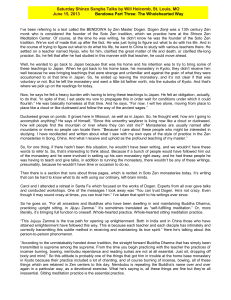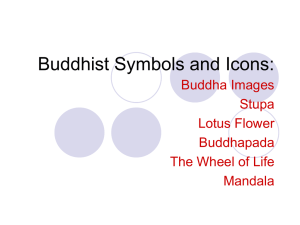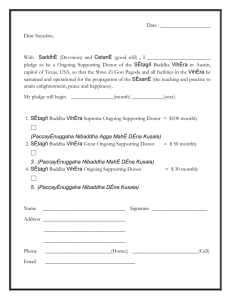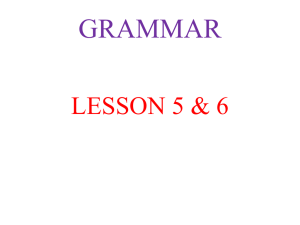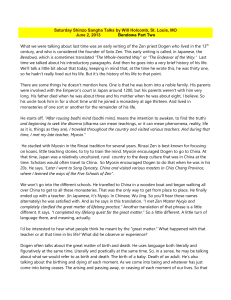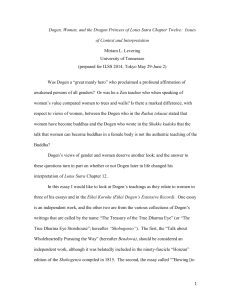Fukanzazengi 3
advertisement
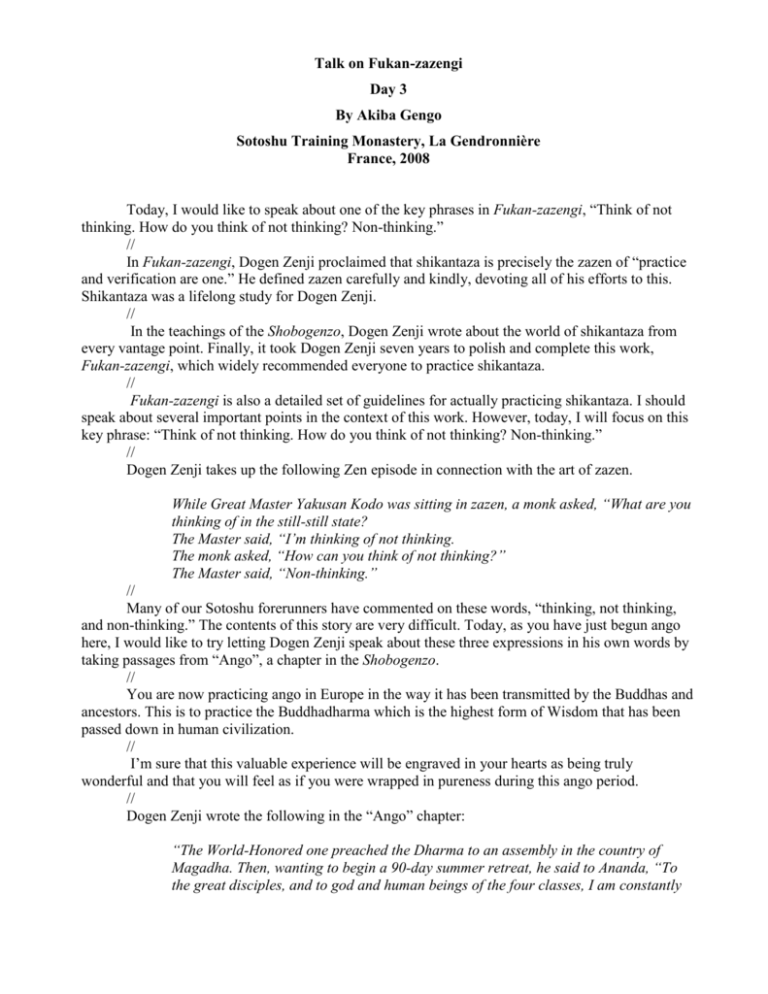
Talk on Fukan-zazengi Day 3 By Akiba Gengo Sotoshu Training Monastery, La Gendronnière France, 2008 Today, I would like to speak about one of the key phrases in Fukan-zazengi, “Think of not thinking. How do you think of not thinking? Non-thinking.” // In Fukan-zazengi, Dogen Zenji proclaimed that shikantaza is precisely the zazen of “practice and verification are one.” He defined zazen carefully and kindly, devoting all of his efforts to this. Shikantaza was a lifelong study for Dogen Zenji. // In the teachings of the Shobogenzo, Dogen Zenji wrote about the world of shikantaza from every vantage point. Finally, it took Dogen Zenji seven years to polish and complete this work, Fukan-zazengi, which widely recommended everyone to practice shikantaza. // Fukan-zazengi is also a detailed set of guidelines for actually practicing shikantaza. I should speak about several important points in the context of this work. However, today, I will focus on this key phrase: “Think of not thinking. How do you think of not thinking? Non-thinking.” // Dogen Zenji takes up the following Zen episode in connection with the art of zazen. While Great Master Yakusan Kodo was sitting in zazen, a monk asked, “What are you thinking of in the still-still state? The Master said, “I’m thinking of not thinking. The monk asked, “How can you think of not thinking?” The Master said, “Non-thinking.” // Many of our Sotoshu forerunners have commented on these words, “thinking, not thinking, and non-thinking.” The contents of this story are very difficult. Today, as you have just begun ango here, I would like to try letting Dogen Zenji speak about these three expressions in his own words by taking passages from “Ango”, a chapter in the Shobogenzo. // You are now practicing ango in Europe in the way it has been transmitted by the Buddhas and ancestors. This is to practice the Buddhadharma which is the highest form of Wisdom that has been passed down in human civilization. // I’m sure that this valuable experience will be engraved in your hearts as being truly wonderful and that you will feel as if you were wrapped in pureness during this ango period. // Dogen Zenji wrote the following in the “Ango” chapter: “The World-Honored one preached the Dharma to an assembly in the country of Magadha. Then, wanting to begin a 90-day summer retreat, he said to Ananda, “To the great disciples, and to god and human beings of the four classes, I am constantly preaching the Dharma, but they do not have reverence or admiration for it. I shall now go inside the Indra’s Stone Hideaway chamber, and practice a 90-day summer sitting. If someone should appear and ask to hear the Dharma, you should preach the following in my place, “All dharmas do not appear. All dharmas do not disappear.” Having spoke, he closed the chamber doors and sat. Since then, 2,194 years have passed.” // This is what Dogen Zenji writes. Now, it is approximately 2,900 years since ango was first practiced. Now ango is being practiced here in Europe, and is something that has been having been passed down from Buddha’s time to the present day. // Later I will speak about this, but one key word in Fukan-zazengi is “non-thinking” which seems to be connected with what Dogen Zenji said is the art of zazen. Dogen Zenji comments on this episode of the Buddha. This is a summary of his comments. “Those Buddhists who have not yet fully known the depths of the Buddha-dharma have often seen the World-Honored One’s closing himself off in the country of Magadha as evidence that the Buddha preached the Dharma without using words. “Those people with a mistaken understanding suppose that because the Buddha shut himself up to do ango and practice zazen means that in the first place it is not possible to completely elucidate the truth by using words. “They think this is nothing more than an expedient means. The ultimate truth is the cutting off of words and something that is beyond the activity of the mind. For this reason, to be without words and without intellect suits the ultimate truth. To use words and to use thought is to deviate from the Truth. “For this reason, the Buddha closed himself up in a chamber for 90 days to concentrate on zazen. He completely cut himself off from any contact with the outside world.” But Dogen Zenji cautions us that this sort of interpretation goes against the intention of the World-Honored One. If we say this, then this means the Dharma (appearing and disappearing, the constant change, the laws and functions that support all existence including human beings) is something that cannot be grasped by means of human capability. This is to say that there is no meaning or significance in words or the function of human intellect. Perhaps it can be said that there is such an aspect. Nevertheless, the natural laws of the universe penetrate all things and are intrinsic to all individual existences. We must see that the function of these laws is the mind which activates the human intellect as well as words themselves following these laws too. This story is, of course, not about the value of silence. Rather, it is to say that the most important point of practicing the Buddhadharma is great compassion, which is to stretch oneself out 2 and enter into any world with the best of our ability to save people by teaching the Dharma or by saving all beings by turning the Dharma. Dogen Zenji is admonishing us to do this. // This story is, of course, not about the value of silence. Rather, it is to say that the most important point of practicing the Buddhadharma is great compassion, which is to stretch oneself out and enter into any world with the best of our ability to save people by teaching the Dharma or by saving all beings by turning the Dharma. Dogen Zenji is admonishing us to do this. // The Buddha said to Ananda, “All dharmas neither appear nor disappear.” Then he said to him, “You should speak in my place.” And then, the Buddha entered the chamber and began the ango by sitting in zazen. Dogen Zenji warns us that you do not overlook Buddha’s conduct. // At that time, Ananda should have said to the Buddha, “You have said that all dharmas neither appear nor disappear, so how should I speak about that? Also, even if I did speak about that, what should I do then?” Dogen Zenji then says he should have listened to the Buddha’s words. // Dogen Zenji writes that the Buddha went into the chamber and closed the doors. But because he had begun ango zazen does not mean that he didn’t speak one word. In terms of expounding the Dharma, this is the most important point, // This universe and great Nature is the phenomenal world. This also applies to our activities. It is in relation to others that this phenomenal world appears and disappears. It is there that things appear and disappear. // This dynamic principle works to cause “existence” and “non-existence” and penetrates all things as well as us. It must be said that our bodies also change into the existence of this dynamic phenomenon. Existence and not existence is “non-existence itself. // This view of the world is called the “viewpoint of emptiness.” It is also called the Dharma. The Buddhist teaching persuades us that the universe and Nature are the form of “the nature of emptiness” appearing. // In other words, all things, including ourselves, are said to be the “Dharma.” The universe and Nature that stretch out in front of our eyes, including ourselves, are the world replete with the Dharma. The “laws of the Dharma” are complete within all existing things. In our own lives as well, thought, concepts, words, and emotions that appear and disappear are the appearance of the truth of the Dharma. // The Buddha taught about this Dharma on Vulture Peak when he raised a flower. Dogen Zenji calls this “expounding the Dharma without discrimination.” Can’t we say that this flower is the activity of this dynamic Dharma law that is “non-thinking?” // Dogen Zenji wrote the following poem: The colors of the mountain peaks and the sounds of the valleys are 3 all the voice and shape of our Shakyamuni Buddha. // These colors of the mountains and the sounds of the valleys were also this way for Dogen Zenji, who heard and saw them as non-thinking. It is the manifestation in this world of the living Dharma. // Gensha Suibi Zenji said, “Throughout the ten directions, there is only this one bright pearl.” Dogen Zenji spoke about this expression. “One pearl” isn’t the name of some particular thing. It is an expression, although there are some people who think it is the name of something. // But it must be said that it is something eternal, without beginning or end, that reaches to the moment now. This body is in this and this mind is in this – that is the bright pearl. Heaven and earth, mountains, rivers, and so forth, are not individual things. There is only one bright pearl. // Dogen Zenji gives a teisho on this one bright pearl. This “one bright pearl” that extends throughout the ten directions is non-thinking. Dogen Zenji concludes the “Ango” chapter in this way: // Having thus inaugurated the summer ango, we make effort in pursuit of the Truth. Even if we have pursued and realized many practices, if we have never done a summer ango we are not descendants of the Buddhist ancestors and we are not Buddhist ancestors. Jetavana Park and Vulture Peak, by virtue of the summer ango, are totally realized. Zazen itself at a summer ango is the mind-seal of the Buddhist Ancestors and is the existence in the world of all the buddhas. // I would like to rephrase these words of Dogen Zenji this way, “In this way, ango is to strive at the practice of zazen. Even if you have done many sorts of practice, you are not a descendant of the Buddha’s if you haven’t done an ango. Jetavana Park and Vulture Peak were manifested through the condition of zazen. The mind-seal of the ancestors’ is nothing other than zazen; it is the appearance and existence of the buddhas in this world.” // I would like to try dividing the story I mentioned earlier about Shakyamuni Buddha and Ananda and the practicing monk in this way. “Think of not-thinking”, this part refers to the practicing monk. “How do you think of not thinking?” this part refers to Ananda. “Non-thinking” refers to Shakyamuni Buddha himself. // That is the way the scene on Vulture Peak took place and the three people were connected through this reality. In this way, we can think that these three expressions – “thinking, not thinking, and non-thinking” – are three concepts and three functions that exist separately. // It seems as if these three people are completely different, but these three people are all endowed with flesh and blood and are the expression of the Dharma. We can say that the bodies of 4 these three people and the way they expressed themselves is “the nature of emptiness.” These three people were practicing ango zazen on Vulture Peak. // Earlier, I introduced a certain portion of text in which Dogen Zenji wrote, “The Buddha said to Ananda, “If someone asks, then preach the Dharma on my behalf. Tell them, ‘All dharmas are neither born nor die.’ Then the Buddha entered samadhi.” // Dogen Zenji said, “We should not vacantly overlook this behavior of the Buddha.” In this way, the Buddha had, by means of non-thinking zazen, sublated the person who was asking the question after the Buddha had said, “All dharmas are neither born nor do they die.” // Is this the way Dogen Zenji thought? The Buddha had sat embracing the three expressions: thinking, not thinking, and non-thinking. // In Zazenshin (“The Acupuncture Needle of Zazen”), Dogen Zenji said the following about these three expressions. The monk asked repeatedly how he could think of not-thinking. “Not thinking” is a word that has been used from long ago. But, indeed, how could he think of “that”? // I think that when we sit in zazen, we cannot say there are absolutely no thoughts. If there were no thoughts, how would it be possible to make progress in zazen? Anyone except a silly fool would want to ask that question. // Yakusan answered the monk saying, “Non-thinking.” He said that he wasn’t thinking. Not thinking means that his mind was completely pure and transparent with no muddiness at all. But in thinking about “not thinking,” then there is no other way to proceed than to use the expression “nonthinking” to pursue this idea. // There is some substance in “non-thinking.” That something is what makes the “self” exist in the existence of “non-thinking.” Surely, it is the “self” that is sitting there in zazen. That “self” isn’t a self that is simply thinking; it is the self that is correctly sitting upright. // Since sitting upright is precisely sitting upright, there is no gap for that “self” that is sitting upright to think of sitting upright. Consequently, that thought of the “self” sitting upright is not Buddha, is not the Dharma, is not satori, and is not any kind of theory about anything. It is only “nonthinking.” // If this body is already the Buddha, then there is no need to become more of a buddha. If the net or cage holding a bird is broken open (in other words, if we break down the words that capture thoughts or the letters that are constraints), then there is no need for a sitting buddha to become a buddha. This is what he is saying. // I think Dogen Zenji would have given a lecture like this about the thoughts of the buddha that embraced Ananda and the practicing monk on Vulture Peak. In the Buddhist sutras, there is the expression that “the Buddha’s state of mind is non-thinking.” I pray that you will realize the 5 compassionate mind in Dogen Zenji’s words so that you can spread the Dharma and liberate all beings. // For those of you experiencing this zazen-practice ango here in Europe, you are descendants of the Buddha, now more than 100 generations following him. You are practicing this zazen of “thinking of not thinking” that has been completely transmitted for a long time. // Zazen verifies how much the sacred Buddha body is manifested in your flesh and blood. I pray that you will take care of your health and complete this 90-day ango. // Finally, I would like to conclude these third times of my unskillful talks by reading the Zazenshin written by Wanshi Zenji. Dogen Zenji highly praised this version of Zazenshin. // Dogen Zenji says, Wanshi Zenji is a Buddhist ancestor among the Buddhist ancestors of the eternal past and present. Former buddhas and later buddhas continue to be spurred on by this acupuncture needle of zazen. Through this needle, ancestors of the present and ancestors of the past are realized. The Zazenshin in question is as follows: Pivotal essence of every buddha, Essential pivot of every ancestor. Not touching things, yet sensing, Not opposing circumstances, yet being illuminated. Not touching things, yet sensing: The sensing is naturally subtle. Not opposing circumstances, yet being illuminated: The illumination is naturally fine. The sensing is naturally subtle: There has been no discriminating thought. The illumination is naturally fine: There has not been the slightest dawning. There has been no discriminating thought: The sensing, without any duality, is singular. There has been not the slightest dawning: The illumination, without any grasping, is complete. The water is clean right to the bottom, Fish are swimming, slowly, slowly. The sky is vast beyond limit, Birds are flying, far, far away. // 6 This Zazenshin teaches about the free activity of zazen; this is what it is saying. This is to “create the Dharma” in a way that is beyond words and forms. It is a principle that transcends the far past until the present day. // Dogen Zenji says that at that place there is no longer, what common people call, Buddhist ancestors and there is no longer our body or mind; there is only a different form of self that seems unfamiliar. // If, after you finish this 90-day ango, your face appears in the shape of another person, have a good laugh when you meet him or her. In this practice here you have only 10 days, you must get used to this schedule for two more month, so you will really concentrate a practice life. Let’s stroll in this world of Shikantaza. I would like to say again. Please take care of your body and mind to be able to balance and happy. In conclusion let me take this opportunity to say a word of thanks and appreciation for the all of people whose effort has made this practice period possible. Thank you very much for listening. 7
